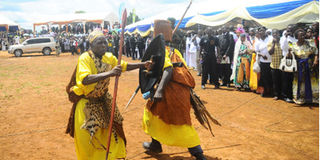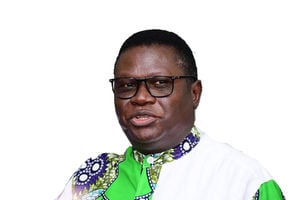Prime
Why the elderly need more social protection

Elderly people perform at a Buganda Kingdom function recently. The elderly are said to be very prone to poverty. Photo by Joseph Kiggundu
What you need to know:
The elderly are usually deemed to be those aged 60 and above and poverty studies have singled them out as one of the groups experiencing deprivation because of their stage in the life cycle (World Bank, 2000).
Uganda has one of the youngest populations with more than 77 per cent of its people under the age of 30.
However, a less mentioned population group is the aging Ugandans who are on average living longer and facing a problem of lack of social protection. With Uganda’s social pension catering for less than 4 per cent of older persons - those aged 60 and above – the majority of the elderly are relegated to a life of near-destitution.
Figures from the Uganda National Household Survey of 2009/2010 showed that the population of older persons was 1.3 million. This survey also found that only 7.1 per cent of older persons had access to pension.
However, there is insufficient debate in the country on how to sustainably raise the social protection net for older people.
An editorial in last week’s Monitor called for the need to expand the social pension which government is providing to senior citizens and suggested that government should make savings for social protection an integral part of the economy. (Expand funding options for the elderly persons, Sunday Monitor, September 28, 2014).
Way forward
Whereas the need to provide social protection for more of our older people is incontestable, the other suggestions advanced by Sunday Monitor (for instance encouraging more Ugandans to finance the scheme and widening the tax base to collect more revenue for the scheme) may not be the most practical in the long term.
In 2010, the Uganda Government launched the Senior Citizens Grant (SCG) under which some citizens aged 65 and above (from 60 years in the Karamoja region) receive Shs25,000 ($10) each month to cater for their welfare. Four years down the road, the scheme has been piloted in only 15 of the country’s 112 districts.
While there has been debate on whether to roll out the programme to more districts, raise age of beneficiaries to 70 years, or do away with the programme, a few other pertinent issues arise.
First, it is worth noting that the Shs25,000 the elderly receive is less than one-sixth of the average monthly income in Uganda.
That said, it should be recalled that, according to studies, nearly one third of all older persons in Uganda live in extreme poverty, are socially disconnected (partly because of their socio-economic status) and face a big burden of taking care of orphans and vulnerable children.
Therefore, while the SCG might look like a pittance, it helps alleviate their considerable financial burden. But will the government be able to cough up the money to include the 96 per cent of older persons not currently benefitting from the scheme? Never forget that the bulk of the funds for the grant scheme comes from donors, notably DFID, Irish Aid and UNICEF.
The reality, however, is that most of today’s younger population could face a similar future. The current formal social security system, including the Uganda National Pensions Scheme run by the Ministry of Public Service and the National Social Security Fund (NSSF), cover only 5 per cent of Uganda’s estimated working population of 13 million.
That means that, barring a change to how we manage savings and pensions, a majority of today’s young people will grow up to face a fate similar to the present older persons.
With all the competing development concerns (universal primary and secondary education, extending power to rural areas, building roads and health infrastructure), government will not afford to pay social pension to us all.
Regrettably, the current scheme under NSSF restricts to those who save with the Fund. Only those working in the formal sector with employers that have a minimum of nine workers do mandatory savings.
Now while the NSSF has had an overly dominant role in the sector, its often poor management and regular reports of corruption that makes it dismally fail to attract savings from the informal sector, it also registered low compliance rates in the formal sector. This created disillusion among actual and potential savers, besides leaving out the greater majority of Ugandan workers.
Pension sector
Current reforms in the pensions sector present a watershed moment as savers will have multiple options of pension schemes to save with, will access their money before reaching the age of 55 as NSSF requires presently, hence they will be able to invest this money. Having multiple players will likely force them to make prudent investment decisions and to give savers a higher return on their money.
These reforms are necessary to ensure that more Ugandans are covered by trusted, efficient and profitable retirement benefit schemes. Those in the private sector, who constitute about 80 per cent of Uganda’s workforce but are currently outside of these schemes, would come into the fold with the reforms.
The Uganda Retirement Benefits Regulatory Authority, which was formed in 2011 to guide the reforms and development of the pensions sector, has already licensed more than 50 schemes and has put in place rigorous guidelines to safeguard workers’ savings.
Through this, URBRA is encouraging the culture of pension savings amongst Ugandans especially in light of the current youth population figures which indicate a wave of older persons on the horizon.
The baseline is that the old need better protection.
REPORT ON POVERTY AMONG ELDERLY
In Uganda, the Participatory Poverty Assessment (PPAs) studies singled out the elderly as one of the groups worst hit by poverty and who are therefore chronically poor, others being the disabled, widowed, street kids, orphans, casual and unskilled labourers (Kimberly, 2003).
The summary PPA report goes further to show that chronic poverty as defined by the poor was a situation “where one survives marginally” and “with problems that follow you”, “living hand to mouth” and “in perpetual need due to lack of basic necessities of life and the means of production”.
Other aspects include lack of social support, feelings of negativity, frustration and powerlessness because “one has no source of life” (Kimberly, 2003).
Conditions of absolute poverty are associated with an absence of income security, inadequate family or social support and poor health combined with inadequate health care (Heslop and Gorman, 2002).
In the Ugandan situation, evidence from the PPA sites indicates that chronic poverty generally resolves around lack of productive assets, lack of access to such assets particularly land (Kimberly, 2003). Physical and social isolation together with insecurity are some of the factors that emerge from explanations of poverty as defined by poor communities themselves.
In most countries of the developing world, health services are perceived by older people to be particularly difficult to access due to many factors including poor attitudes of health staff towards poor people, shortage of supplies, lack of information, lack of funds and poor implementation structures (Heslop and Gorman, 2002).
In Uganda, there are almost no specialized health care services for the elderly in the government health facilities, with the negative attitudes of service providers and poverty not withstanding.
The PPA findings from Uganda reveal that distances to health facilities, lack of physical and financial capacity to reach the facility and the cost incurred for treatment including drugs are some of the factors that hinder older persons from accessing health care (Kimberly, 2003).
Uganda’s population is around 87 per cent rural and as stressed by Heslop and Gorman (2002), rural communities have a high concentration of old people in poverty.
The summary report of the PPA sites lays out some of the features of the poor rural community as described by the respondents and these were: inaccessible or remote; lacking social services and safe water sources; with limited shelters and poor housing; isolated with no help from district authorities; faced with seasonal food shortages; and insecurity (Kimberly, 2003).
(By Innocent Najjumba-Mulindwa, Makerere University)




